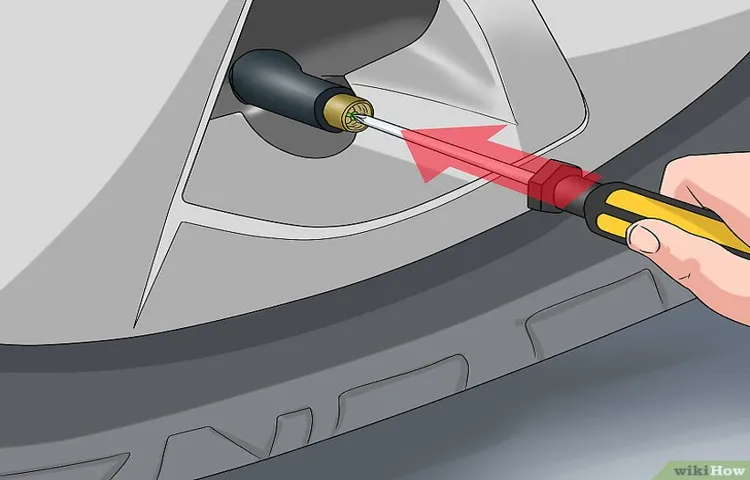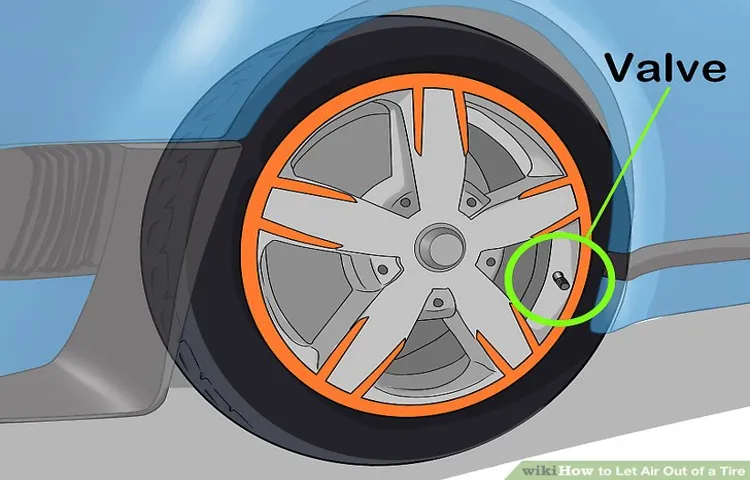Do you want to know how to let air out of a tire? Whether you have a flat tire that needs repairing or you simply need to adjust the air pressure in your tires, learning how to do this basic maintenance task is an important skill for any driver. It may seem like a simple process, but there are a few things to keep in mind to ensure you do it safely and effectively. In this step-by-step guide, we’ll walk you through the process of letting air out of a tire.
We’ll cover everything from the tools you need, to how to find the valve stem, to how to actually release the air from the tire. By the end of this guide, you’ll be an expert at letting air out of your tires. So grab your tire pressure gauge and let’s get started!
Table of Contents
Gather necessary tools
Want to know how to let some air out of a tire? It’s actually quite a simple process, but you’ll need a few tools to get the job done. First up, you’ll need a tire pressure gauge to check the current pressure of the tire before you begin releasing any air. It’s important to know what the pressure is beforehand so you don’t let out too much air by accident.
Next, you’ll need a valve stem tool. This tool is used to remove the valve cap from the valve stem, which is necessary to be able to release any air. You can find valve stem tools at most automotive stores.
Finally, you’ll need something to release the air, like a small nail or a screwdriver. Be careful when using these tools, as you don’t want to damage the tire or valve stem. Once you have all the tools you need, you’re ready to start letting some air out of that tire!
Examples: tire pressure gauge, valve stem tool, valve caps
When it comes to maintaining your vehicle, having the right tools is crucial for ensuring your car stays in top condition. Some of the essential tools you should keep on hand include a tire pressure gauge, a valve stem tool, and valve caps. These three tools work together to help you maintain your tires and ensure they are functioning properly.
The tire pressure gauge allows you to check the air pressure in your tires and ensure they are inflated to the correct level. The valve stem tool helps you remove and install valve stems, which can become damaged over time or when changing tires. The valve caps help keep dirt and debris out of the valve stem, which can cause leaks or other issues.
By keeping these tools on hand, you can quickly and easily maintain your tires and keep your car running smoothly.

Remove valve stem cap
When it comes to letting some air out of your tire, it may seem like a tricky task, but it’s actually quite simple. The first step is to remove the valve stem cap that covers the valve stem. This can be done easily by twisting it counterclockwise with your fingers.
Once the cap is off, you’ll see the valve stem itself, which is what you’ll need to manipulate to release some air. You can use a tire pressure gauge or even a flathead screwdriver to press down on the stem’s center pin, which opens the valve and allows air to escape. Just be sure to only release small amounts of air at a time, and to check the tire pressure frequently with a gauge as you go to ensure you don’t let too much air out.
By following these steps, you’ll have no trouble adjusting your tire pressure to the proper level.
Twist counterclockwise until loose; set aside safely
Removing valve stem caps may seem like a straightforward process, but it requires attention to detail to ensure it is done safely and correctly. To begin, locate the valve stem cap on the tire, which can be found near the edge of the rim. Next, twist counterclockwise until it becomes loose.
It’s essential to set the valve stem cap aside safely to prevent misplacing it. Removing the valve stem cap exposes the valve core inside the stem. This small part is crucial because it controls the air pressure in the tire.
Avoid touching or damaging the core while the cap is off to prevent air from escaping. With the valve stem cap removed, it’s easier to add or release air pressure from the tire, which ensures a smooth driving experience. Remember to replace the valve stem cap correctly after the tire maintenance is complete to avoid any issues in the future.
Regularly inspecting and maintaining the valve stem cap is an excellent way to prevent flat tires and extend the life of the tire.
Press valve stem
If you need to let some air out of your tire, the first step is to locate the valve stem. It’s typically a small protrusion on the rim that looks like a cap with a small stem sticking out of it. Once you’ve found the valve stem, you’ll need to press down on it with a valve stem tool or the tip of a pen to release some of the air.
Be sure not to completely remove the cap from the valve stem, as this can cause the tire to rapidly deflate. It’s also important to check the pressure gauge frequently to make sure you’ve released enough air to reach your desired tire pressure. Remember that overinflated tires can be just as dangerous as underinflated ones, so be sure to keep your tires at the recommended pressure for optimal performance and safety.
Place tire pressure gauge/tip of valve stem tool onto valve stem
When checking tire pressure, it’s important to place the tire pressure gauge or tip of the valve stem tool directly onto the valve stem. This ensures an accurate reading and can help prevent damage to the valve stem. To do this, simply press the tip of the gauge or tool onto the valve stem and hold it there firmly until the gauge or tool registers the tire pressure.
It’s important to ensure there are no leaks or hissing sounds when taking the reading, as this can indicate a problem with the valve stem or tire. Remember, maintaining proper tire pressure is crucial for keeping your car running smoothly and safely on the road. So, take the time to check your tire pressure regularly and use the proper tools to get an accurate reading every time.
Gently press down on gauge or tool to release air
When it comes to checking your tire pressure, it’s important to know how to properly use a gauge or tool to release air. One of the most crucial steps in this process is pressing the valve stem. This small piece is what allows air to enter and exit your tire, and pressing it will release air so you can accurately measure your tire pressure.
However, it’s important to gently press down on the gauge or tool, as applying too much pressure could cause your tire to completely deflate. With a bit of practice, you’ll become comfortable using a tire gauge and understanding how to properly release air to maintain optimal tire pressure. Remember, keeping your tires properly inflated not only ensures your safety on the road, but also helps to extend the life of your tires.
Re-check tire pressure
If you need to let some air out of your tire, the first thing you should do is find a pressure gauge. You don’t want to let out too much air, so it’s important that you know how much air is in the tire before you begin. Once you have that information, take a small object like a screwdriver and press it onto the valve stem to release the air.
Be sure to release the air slowly and check the tire pressure every few seconds with the gauge to make sure you don’t remove too much air. This process can be a bit time-consuming but it’s necessary to ensure that your tire pressure is at the right level. Remember that keeping your tires properly inflated is important for your safety on the road and can also help improve gas mileage and prolong the life of your tires.
Use tire pressure gauge to ensure correct air pressure
If you want to ensure a smooth and safe drive, it’s crucial to keep your tires at the correct pressure. Using a tire pressure gauge is the easiest and most accurate way to do this. You simply need to attach the gauge to the valve stem and read the pressure display.
However, it’s not enough to check the pressure once and assume everything is okay. Tires lose air over time, and changes in temperature and driving conditions can also affect the pressure. Therefore, it’s essential to re-check the pressure regularly and adjust it if necessary.
By doing so, you’ll not only improve your car’s performance and fuel efficiency but also reduce the risk of blowouts and other tire-related issues. So don’t neglect this simple but vital task, and make it a regular part of your car maintenance routine.
Replace valve stem cap
If you need to let some air out of your tire, one easy way to do so is by removing the valve stem cap. This small cap sits on top of the valve stem and keeps air from escaping, but it can easily be unscrewed by hand. Before you remove the cap, make sure you have a tire gauge handy so you can check the pressure and make sure you release the right amount of air.
Once you have the cap off, press down on the valve stem with the gauge to release the air. Be sure to only release a little air at a time and check the pressure frequently. Once you have the desired pressure, you can replace the valve stem cap and you’re good to go.
It’s important to note that if you need to let out a significant amount of air, it’s best to take your tire to a professional to ensure it is not damaged in the process.
Twist clockwise until tight; do not overtighten
Valve stem caps are an essential part of any vehicle, and it’s important to replace them as soon as they’re lost or damaged. Whenever replacing a valve stem cap, make sure to twist it clockwise until tight, but don’t overtighten it. Overtightening the cap can cause damage to the valve stem, which can lead to expensive repairs down the line.
A good rule of thumb is to tighten the cap just enough so that it won’t come off easily if bumped or jostled. It’s also a good idea to check the cap periodically to make sure it’s still tight and secure. By taking care of your valve stems and replacing caps as needed, you’ll help ensure that your tires are properly inflated and your vehicle is in top condition for years to come.
Remember, a little bit of maintenance goes a long way in keeping your vehicle safe and reliable!
Tips for letting air out of tire safely
Learning how to let some air out of your tire safely can be handy knowledge to have when you need to adjust your tire pressure for better traction or fuel economy. The first step is to find a pressure gauge and check the current PSI of your tire to ensure you don’t release too much air. Once you know how much air you want to let out, locate the valve stem and unscrew the valve cap.
Then, press down on the valve stem with a tire pressure gauge or a small object like a paper clip. Make sure to only release a small amount of air at a time and check the pressure frequently to ensure you don’t go past the desired PSI. It’s crucial to remember that over-deflating your tire can lead to blowout or damage to the tire structure, so always approach this task carefully.
By following these steps, you can safely reduce your tire pressure and gain better control over your vehicle without compromising safety.
Avoid kneeling or standing directly in front of tire
When it comes to letting air out of your tire, safety should always come first. One important tip to keep in mind is to avoid kneeling or standing directly in front of the tire. This may sound obvious, but accidents can happen when you least expect them.
For example, if the tire suddenly bursts or the valve stem breaks, you could be hit with high-pressure air, causing serious injury. Instead, position yourself to the side of the tire, so that you can easily access the valve stem without putting yourself in harm’s way. Remember, taking a few extra seconds to ensure your safety is always worth it in the long run.
Avoid using sharp objects to deflate tire
When it comes to letting air out of your tire, there are a few precautions you should take to avoid putting yourself and others in danger. It’s best to avoid using sharp objects to deflate your tire, as this could cause it to burst suddenly and potentially cause serious injury. Instead, opt for a tire pressure gauge or a valve tool specifically designed for deflating tires.
These tools are much safer and less likely to cause harm. Additionally, be sure to only let out the necessary amount of air, as over-deflating your tire can also be dangerous and cause handling issues while driving. By taking these precautions, you can safely and effectively let out air from your tire when necessary.
Remember, safety should always be your top priority.
Conclusion
In conclusion, letting air out of a tire may seem like a daunting task, but with a little bit of know-how, it’s as easy as releasing a breath. Just remember to have the proper tools, such as a tire gauge, and be mindful of the recommended tire pressure. And if all else fails, don’t be afraid to ask for help – after all, there’s no shame in letting a little air out of your ego to keep your car running smoothly!”
FAQs
Why would someone want to let air out of their tire?
There are a few reasons someone might want to let air out of their tire, such as if the tire is overinflated or if they need to adjust the tire pressure for a specific type of terrain.
Is it dangerous to let air out of a tire?
It is generally safe to let some air out of a tire, but it is important to make sure that the tire pressure is still within the recommended range for the specific tire.
What tools do I need to let air out of my tire?
You will need a tire pressure gauge and a tire valve tool to remove the valve stem cap and release air from the tire.
How much air should I let out of my tire?
This will depend on the specific tire and the reason for releasing air. It is best to consult with the manufacturer’s recommendations or a professional mechanic for guidance.
Can I let air out of my tire without a valve tool?
While it is possible to release air without a valve tool, it is not recommended as it can damage the valve stem or lead to uneven pressure release.
How do I know if I’ve let out enough air from my tire?
You can use a tire pressure gauge to check the pressure after letting some air out. The pressure should be within the recommended range for the specific tire.
How often should I check my tire pressure and make adjustments?
It is recommended to check tire pressure at least once a month and make any necessary adjustments to ensure optimal tire performance and longevity.



